Employee experience is an umbrella term that describes employee and employer interactions, from the initial hiring process to daily work activities and career development opportunities.
Many employers fail to realize that employee engagement stems from more than free snacks and beverages and employee discounts. It’s about creating a comprehensive work environment that considers employees’ well-being, development, and happiness.
A reliance on traditional employee experience quickly became unfeasible in the wake of COVID-19 and the following economic disruption, with employees and employers alike having to navigate the shifting nature of work.
One-third of respondents in a recent McKinsey survey said their return to work had had a negative impact on their mental health, and almost half of those who had not yet returned anticipated negative mental health impacts.
In 2023, where talented employees have many options, business leaders and HR professionals must adopt a holistic approach to enhanced employee experiences to maintain employee satisfaction and increase business velocity.
This article will explore ten tried and tested employee experience strategies businesses can use to create a productive, enjoyable, and fulfilling workplace for their employees. After reading, you’ll have the tools to ensure your organization excels in employee experience and reap the rewards of a satisfied and engaged workforce.
What Is Employee Experience?
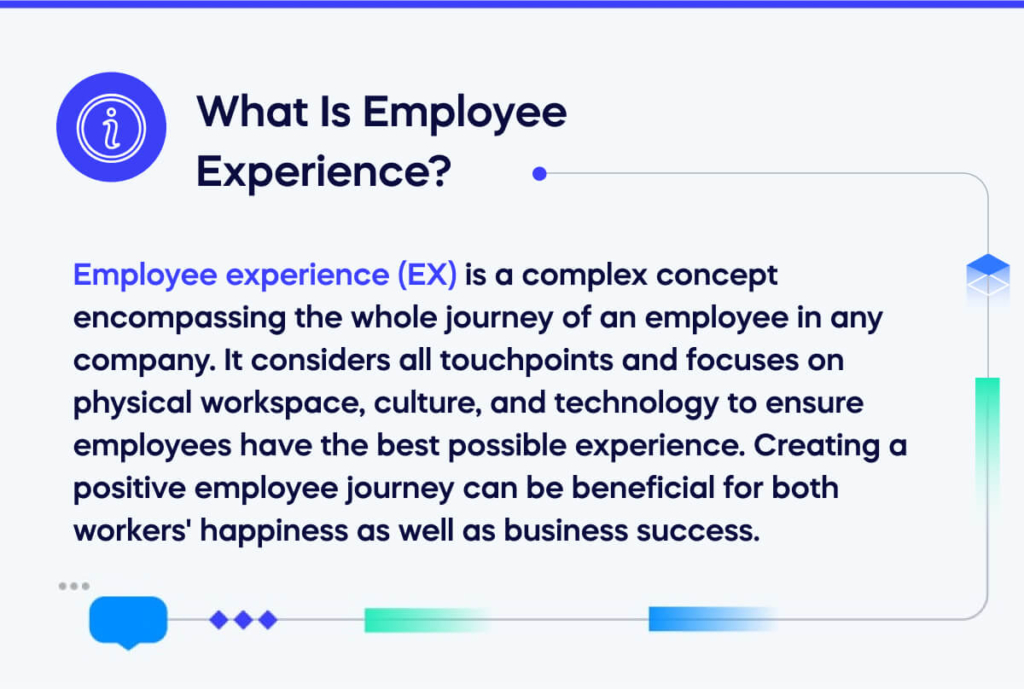
Employee experience (EX) is a complex concept encompassing the whole journey of an employee in any company. It considers all touchpoints and focuses on physical workspace, culture, and technology to ensure employees have the best possible experience. Creating a positive employee journey can be beneficial for both workers’ happiness as well as business success.
Why Is Employee Experience Important?
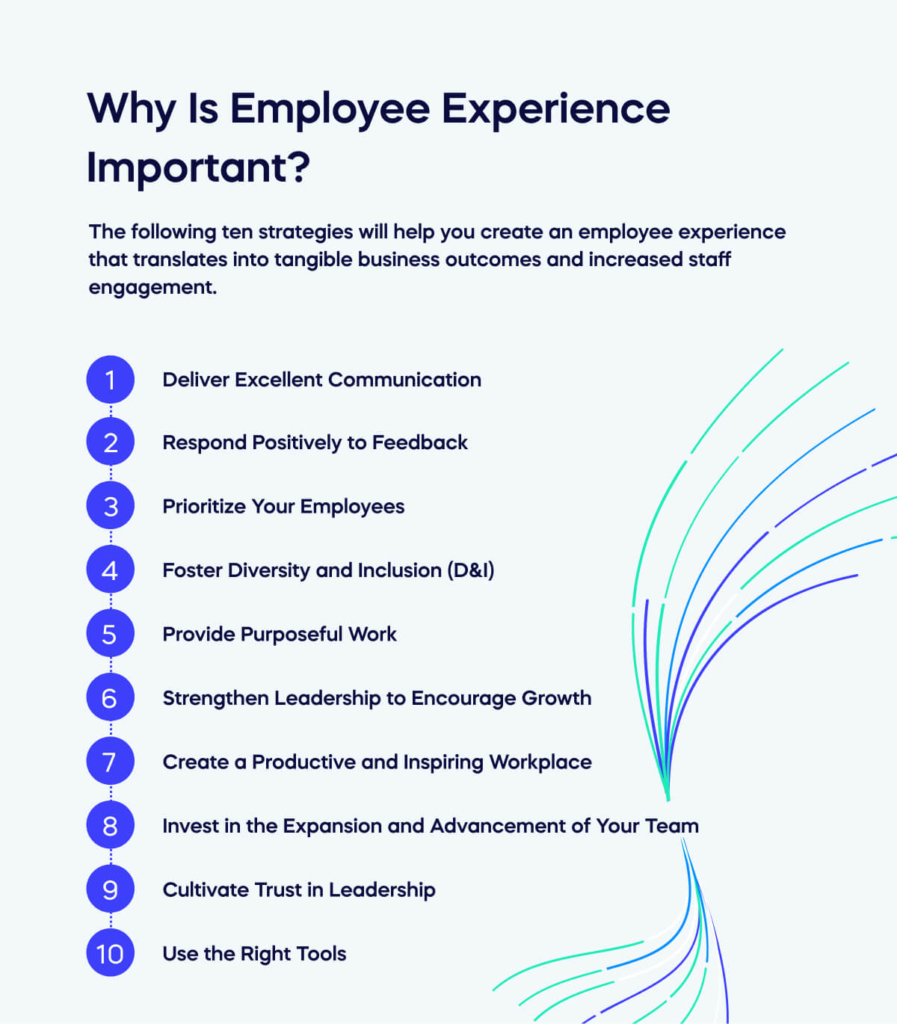
For a business to reach its true potential, it must make the employee experience their top priority. It affects retention, turnover rates, and other key success metrics, including productivity, culture, and revenue growth.
A business is far more than just a product, service, or physical premises. The human element lies at its core, and investing in and caring for your people yields immense rewards.
The following ten strategies will help you create an employee experience that translates into tangible business outcomes and increased staff engagement.
1. Deliver Excellent Communication
Strengthening the connection with your employees is not much different from any other relationship – it requires meaningful dialogue.
Although HR leaders and business professionals recognize the significance of communication, they invest more time conversing with stakeholders, media outlets, and their target audience than in internal employee communications.
You must switch your perspective and place employees in the center to improve communication. Investing in effective communication platforms and technologies can make it easier to get messages across, connect with employees, and measure the success of your communication strategies.
2. Respond Positively to Feedback
To gain insight into what your employees need from you, the most effective course of action is to solicit their feedback and then attentively listen when they answer.
Nowadays, you can easily access pulse survey platforms, open survey systems, and performance management software to constantly stay informed about your employees’ thoughts about the company. Using these tools regularly will help you identify the positives people take away from working for your organization and how to improve their experience.
To ensure that you receive honest feedback from your employees, it is essential to have a culture of mutual respect and open dialogue at all times. If your team perceives that their opinions are neglected or disregarded in routine settings, they will be less likely to share candor with you when it matters most.
3. Prioritize Your Employees
Crafting a remarkable employee experience should be at the forefront of your mind throughout each transition in an employee’s life cycle, from recruitment to departure. Each interaction is a chance to enhance and produce a positive employee atmosphere.
Exploring the employee experience through a holistic, life-cycle lens can generate insightful questions such as:
- Is our hiring process approachable and equitable?
- Does onboarding ensure that incoming staff members experience our core values?
- Are our employees advancing and developing professionally with us?
- How do people feel about their time with us when they leave?
Answering these questions will give you a glimpse into your work environment from an employee’s point-of-view, unveiling where improvements may be necessary.
4. Foster Diversity and Inclusion (D&I)
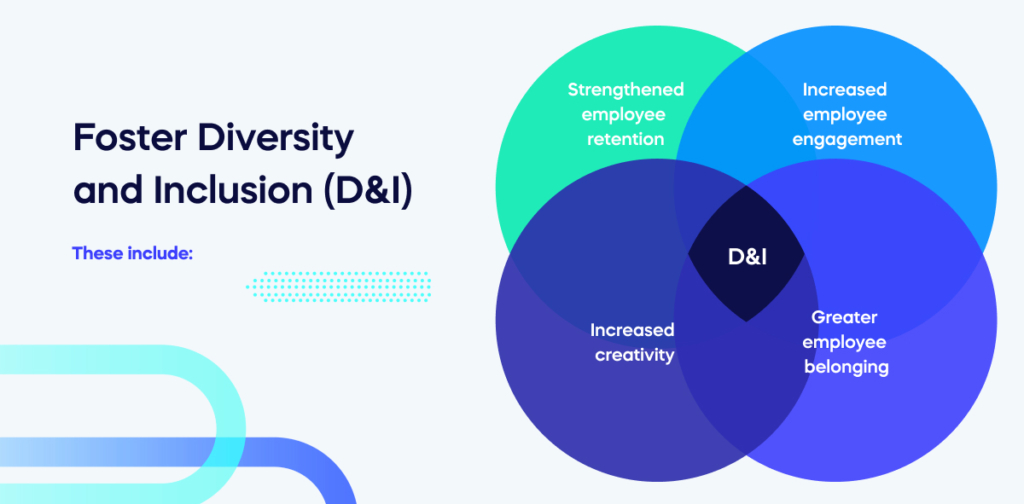
An extensive study in the European Journal of Training and Development (2022) revealed that a diverse workforce significantly benefits human capital outcomes.
These include:
- Strengthened employee retention
- Increased employee engagement
- Increased creativity
- Greater employee belonging
As the research illustrated, organizations with diversity and inclusion policies perform better than those without. Creating a D&I strategy focused on talent attraction, development, and retention is essential to unlocking your team’s full potential. This will ensure an enduring commitment to cultural diversity within your organization for years.
Show your employees that you value them and prioritize diversity by ensuring your organization’s tools, websites, and systems are available in multiple languages.
5. Provide Purposeful Work
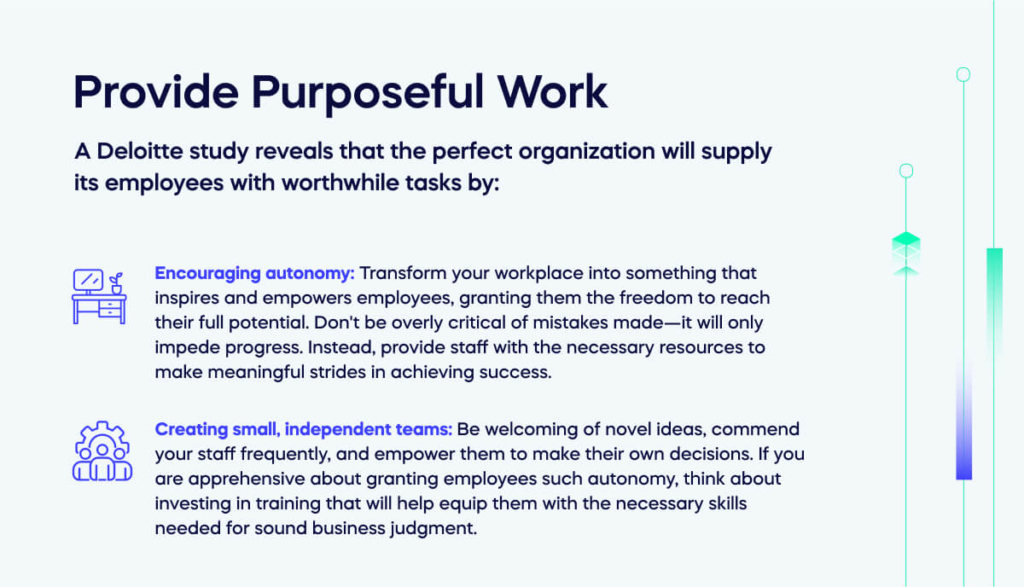
A Deloitte study reveals that the perfect organization will supply its employees with worthwhile tasks by:
- Encouraging autonomy: Transform your workplace into something that inspires and empowers employees, granting them the freedom to reach their full potential. Don’t be overly critical of mistakes made—it will only impede progress. Instead, provide staff with the necessary resources to make meaningful strides in achieving success.
- Creating small, independent teams: Be welcoming of novel ideas, commend your staff frequently, and empower them to make their own decisions. If you are apprehensive about granting employees such autonomy, think about investing in training that will help equip them with the necessary skills needed for sound business judgment.
6. Strengthen Leadership to Encourage Growth
Outstanding managers promote an atmosphere of support for their staff during everyday duties. They communicate objectives clearly and transparently so that everyone is on the same page regarding long-term decisions, eliminating any guesswork.
Supportive managers offer their employees not only authoritative direction but also meaningful coaching. They provide frequent feedback, inspire the team to learn from each other, and build self-assurance, all while inquiring earnestly about how they can help the employee reach desired objectives.
Leaders should focus on the employee’s skills and strengths to encourage growth rather than weaknesses. They should also provide useful resources such as training, mentorship, and support.
7. Create a Productive and Inspiring Workplace
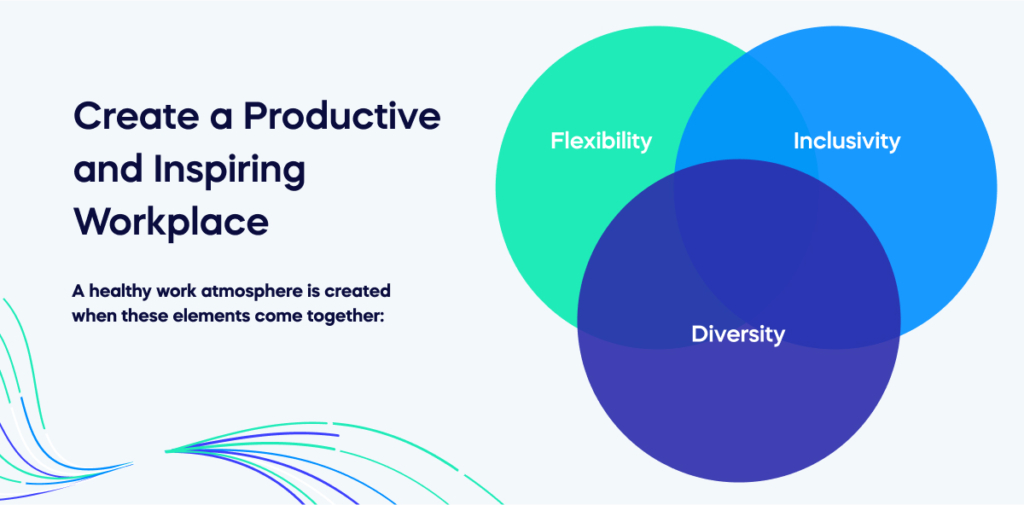
A healthy work atmosphere is created when these elements come together:
- Flexibility
- Inclusivity
- Diversity
Offering a more flexible work atmosphere allows employees to tailor their environment and hours per their preferences. Not only is this beneficial for employee well-being, but it has also been demonstrated to enhance job satisfaction, productivity, and health; while decreasing costs, stress levels, and absenteeism.
It is important to foster an atmosphere of inclusivity and diversity by monitoring employee interactions, recognizing inclusive practices, and providing unconscious bias training for all managers. Hostile behaviors should be actively addressed in the workplace to ensure a safe environment for employees from all backgrounds.
Recognizing employees’ successes is an effective way to make them feel appreciated and motivated. There are numerous ways to recognize employee achievements, such as encouraging peer-to-peer awards, sharing success stories on the company website or social media channels, or featuring blog posts written by staff members.
8. Invest in the Expansion and Advancement of Your Team
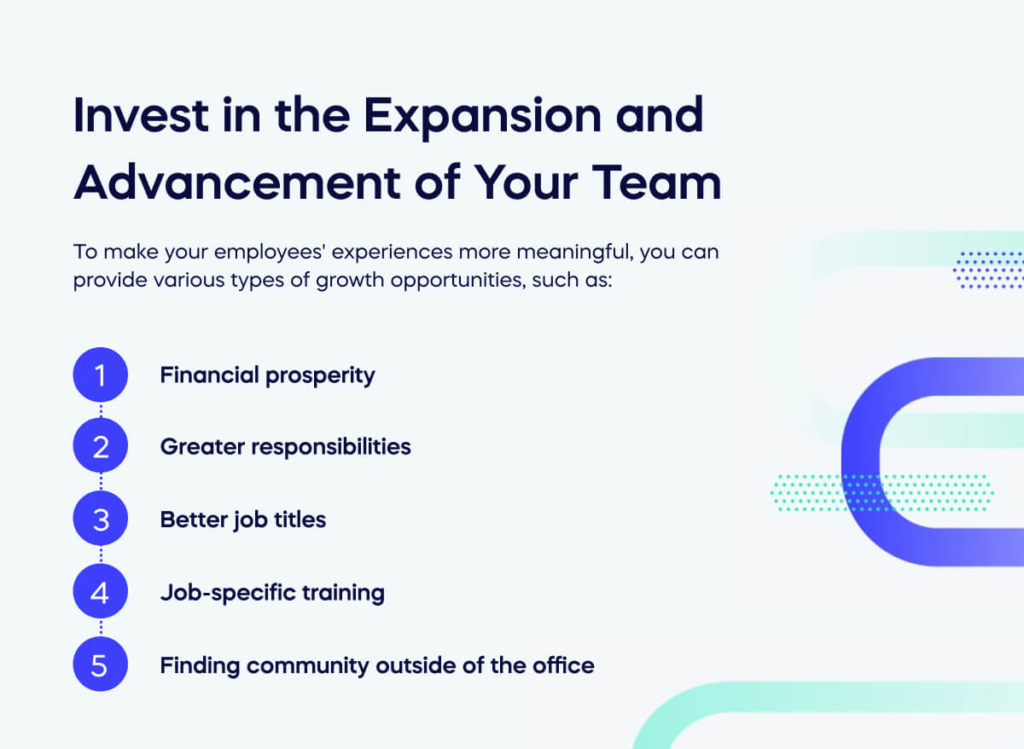
According to DecisionWise’s research, a dishearteningly low number of 43% of employees reported feeling that their employers gave them good opportunities for growth and development.
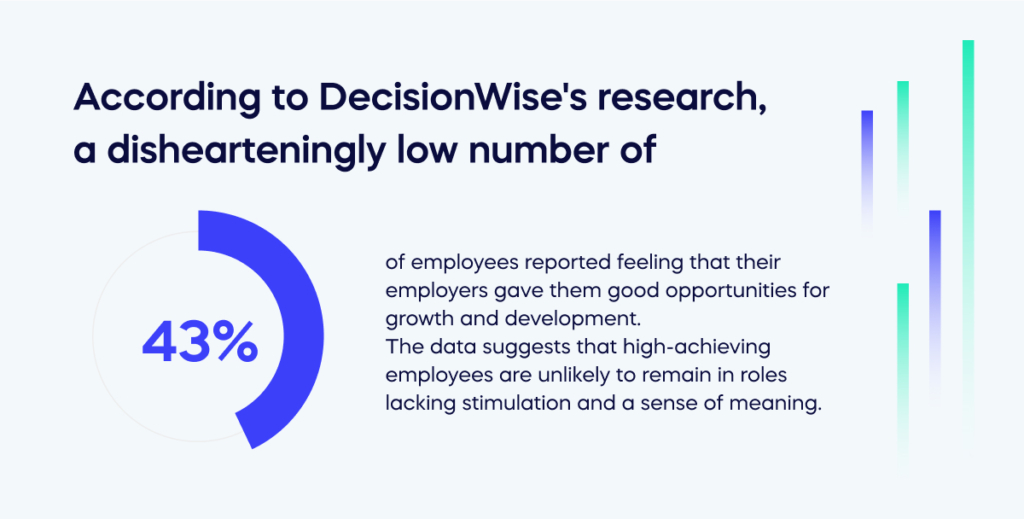
The data suggests that high-achieving employees are unlikely to remain in roles lacking stimulation and a sense of meaning.
To make your employees’ experiences more meaningful, you can provide various types of growth opportunities, such as:
- Financial prosperity
- Greater responsibilities
- Better job titles
- Job-specific training
- Finding community outside of the office
9. Cultivate Trust in Leadership
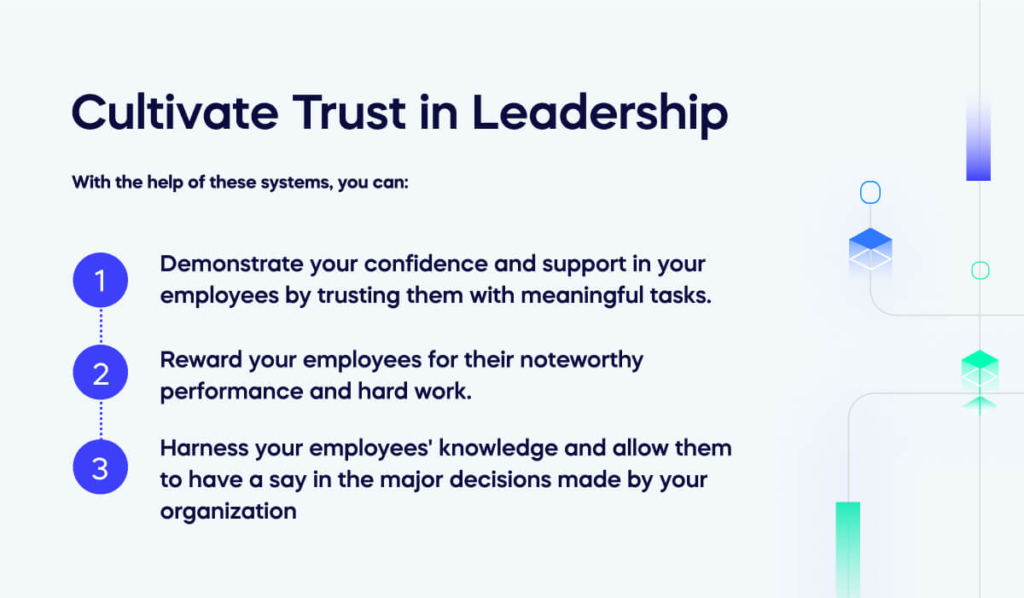
Your employees must know and understand its mission and goals to engender absolute trust in your organization’s leadership. Communication from top executives should always be truthful, open-ended, and motivating.
Your employees must continually be aware that you value their commitment since they invest so much into your business.
Invest in your employees and encourage them to reach their potential with the help of an
With the help of these systems, you can:
- Demonstrate your confidence and support in your employees by trusting them with meaningful tasks.
- Reward your employees for their noteworthy performance and hard work.
- Harness your employees’ knowledge and allow them to have a say in the major decisions made by your organization
10. Use the Right Tools
Employers have many options to supercharge the employee experience, such as delivering clear and concise communication or granting employees meaningful job opportunities.
But the right tools and processes can make even greater improvements. Technologies like AI, Machine Learning, and Analytics are increasingly used to measure employee experience, giving employers more insight into their employees’ current satisfaction and well-being.
These same tools can increase employee engagement through targeted feedback loops that allow managers to measure employee engagement and satisfaction on a more personal level.
By utilizing the right tools, employers will have greater insight into their employees’ experiences, allowing them to make informed decisions and better support their teams.
Getting The Most Out Of The Employee Experience
The importance of employee experience is undeniable, and employers should take the initiative to prioritize their employees’ needs. By investing in their team’s satisfaction and well-being, employers can create a positive work environment that benefits employees and drives long-term success for the organization.
Continue to invest in your employees, and they will, in turn, remain committed to helping your organization grow. With the right tools and strategies, you can create an employee experience that is second to none.


